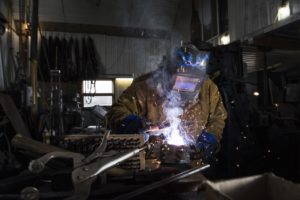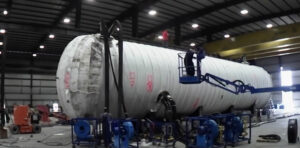Thermal insulation is a general term used among the industry to describe glass fiber blanket insulation. The insulation blankets are applied directly to a workpiece to reduce heat loss by creating a “thermal barrier” between areas that have major temperature differences. Insulation assists in providing constant temperatures and controlled environments that are necessary for heat treatment. It is used in various applications on each and every heat treating job and is a vital component to all heat treating procedures.
Carefully installed insulation on a pair of Pressure Vessels during PWHT (post weld heat treatment.)
What is it?
“Blanket” type insulation is produced from high-quality spun glass fibers that have a high tensile strength and resiliency. It comes in a variety of densities and sizes and has a 2,300°F (1,260°C) maximum temperature rating. Gulf Coast Combustion uses 1” thick, 8 lb. density Kaowool Blanket S Insulation.
The insulation is made mostly of recycled glass that has been melted down and spun into fine strands of wool. The strands of wool are formed into rolls that GCC uses on “localized” applications such as: pressure vessels, spool piping, flanges, heat exchangers, rail cars, refractory, and furnaces, to name a few.
How is it used?
When possible, insulation must be applied on the opposite side of the material or weld being treated to stop heat loss and to achieve an adequate heat soak. Additionally, being wrapped or attached around a heating element such as a Flexible Ceramic Heater or Combustion Gas Burner creates an “oven” effect. On steel alloys, the “oven” produces a still air atmosphere that will consume the oxygen and reduce the effects that iron oxide has on them.
Insulation must be installed correctly to achieve proper heat treatment and to minimize harmful temperature gradients. A temperature gradient describes which direction and at what rate the temperature changes the most rapidly around a particular location. Insulation may be attached by banding, iron wire, tape, stud pins, wire road mesh, and/or welding pins or rods. Note: Insulating methods are not limited to the procedures listed, but are a preferred method.
Insulation blankets are unaffected by water and physical properties of the insulation are restored after drying. Insulation is a consumable material that should be disposed of promptly after each cycle of use. The glass fibers will start to degrade after wrapping, attaching, and removing the insulation.
Safety precautions:
Mishandling of insulation can result in skin, eye or respiratory irritation with prolonged contact. GCC technicians must handle insulation with gloves at all times. Safety glasses, long sleeves and pants must also be worn to reduce or eliminate any irritation. In confined areas with particularly limited air movement, technicians must always use dust masks or respirators with particle filters.
Please visit our Services Offered page or contact us for more information.



